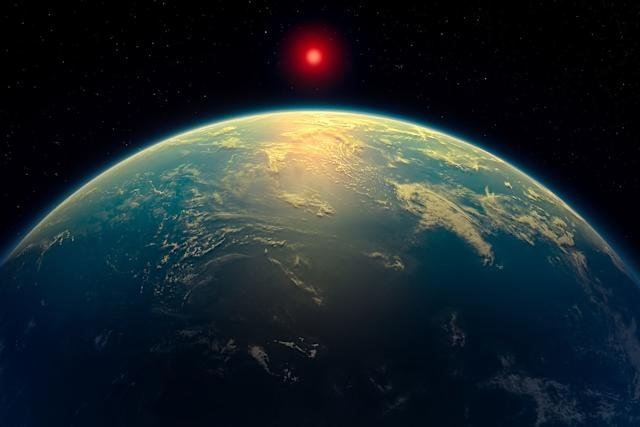
Signs of Life on K2-18B
Signs of Life on K2-18B
Written by: Keya Gambhir
Imagine looking through a telescope at a planet far, far away and discovering something that might show signs of life. That’s exactly what scientists have recently done! They’ve spotted what could be a sign that life, or at least the ingredients for life, might exist on a planet called K2-18b. This planet is 124 light-years away from Earth, meaning it’s extremely far from us!
What Makes K2-18b Special?
K2-18b may be a Hycean world, which means it might have a giant ocean beneath its atmosphere. This could make it a good candidate for life, as it might have the right conditions for liquid water, just like Earth. The planet orbits its star in the "habitable zone," where temperatures are just right for water to exist in liquid form.
Scientists first suggested that planets like K2-18b could exist in 2021. Now, they’ve found new signs of possible life using the James Webb Space Telescope, a super-powerful telescope. This tool can study distant planets and figure out what chemicals are in their atmospheres. However, scientists remain cautious and are unable to currently confirm life on the planet.
What Did Scientists Find?
Using the James Webb Space Telescope, scientists detected chemicals called dimethyl sulfide and possibly dimethyl disulfide in K2-18b’s atmosphere. On Earth, these chemicals are made by microbes, tiny living organisms like marine phytoplankton. While these chemicals could also be created by unknown chemical processes on K2-18b, the fact that they’ve been found there is exciting because they are usually linked to life on Earth.
Even though this is exciting, scientists are careful not to claim they’ve found life just yet. The chemicals could have been made by something else, but the discovery is still one of the strongest signs we’ve found of life on another planet.
How Did They Make This Discovery?
To figure out what’s in the atmosphere of distant planets, scientists look at the light from the star the planet orbits. As the planet passes in front of its star, some of the star’s light shines through the planet’s atmosphere. By studying how the light changes, scientists can figure out what gases are in the atmosphere.
Earlier, scientists noticed a weaker signal from K2-18b that could suggest the presence of dimethyl sulfide. But the new discovery, using a different tool on the James Webb Space Telescope, confirmed this signal. This time, the signal was strong and clear, adding more evidence that dimethyl sulfide or dimethyl disulfide might be in the atmosphere.
Why Are Scientists Being Cautious?
Even though the discovery is exciting, scientists are careful because the signal isn’t perfect yet. The results are statistically significant (meaning it’s very unlikely the results are just a fluke), but they still need more data. To be really sure, the results need to meet the five-sigma threshold, which means the chance of the results happening by chance would be less than 0.00006%. The researchers hope to observe K2-18b for another 16 to 24 hours with the James Webb Space Telescope to gather more data.
What’s Special About K2-18b?
K2-18b is 8.6 times as massive and 2.6 times as large as Earth. Massive refers to the amount of matter a planet contains. In simple terms, a more massive planet has more weight and more gravity, even if it isn't physically very big. A planet with a lot of mass would be heavier compared to a planet of similar size. Large refers to the physical size of the planet. It means how big the planet is in terms of volume or diameter. A large planet could be big but not necessarily heavy if it doesn't have much mass.
It’s located in the Leo constellation, and it's far from Earth, making it hard to study. Still, earlier observations of the planet found methane and carbon dioxide in its atmosphere, which suggested that the planet might be covered by a vast ocean beneath a hydrogen-rich atmosphere. This would make it a Hycean world, which is a type of planet thought to have the right conditions for life.
What’s Next?
While scientists are still being careful, the new data from the James Webb Space Telescope has excited many researchers. It’s possible that we’re getting closer to discovering life on another planet. To confirm the results, the team will need to do more tests, but this discovery shows that we are one step closer to answering the question: Are we alone in the universe?
The study of planets like K2-18b could be a big step in humanity’s search for life beyond Earth. Even though we don’t know for sure if life exists on K2-18b, the evidence is stronger than ever, and this is just the beginning. The future is bright for discovering new planets and maybe even new life out there in the universe!
References
"Strongest Hints of Biological Activity Found on Exoplanet," University of Cambridge, accessed April 19, 2025, https://www.cam.ac.uk/stories/strongest-hints-of-biological-activity.
Ashley Strickland, "Scientists Find Potential Signs of Life on Exoplanet K2-18b," CNN, April 17, 2025, https://www.cnn.com/2025/04/17/science/k218b-potential-biosignature-webb/index.html.
"Scientists Find Potential Evidence of Life on Exoplanet K2-18b," CBS News, April 17, 2025, https://www.cbsnews.com/news/k2-18b-planet-life-evidence-scientists/.


